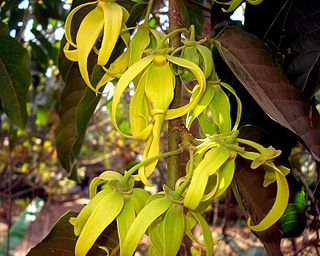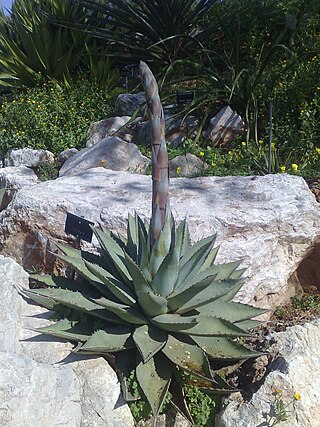
Iris is a flowering plant genus of 310 accepted species with showy flowers. As well as being the scientific name, iris is also widely used as a common name for all Iris species, as well as some belonging to other closely related genera. A common name for some species is flags, while the plants of the subgenus Scorpiris are widely known as junos, particularly in horticulture. It is a popular garden flower.

Yucca is a genus of perennial shrubs and trees in the family Asparagaceae, subfamily Agavoideae. Its 40–50 species are notable for their rosettes of evergreen, tough, sword-shaped leaves and large terminal panicles of white or whitish flowers. They are native to the Americas and the Caribbean in a wide range of habitats, from humid rainforest and wet subtropical ecosystems to the hot and dry (arid) deserts and savanna.

Agavoideae is a subfamily of monocot flowering plants in the family Asparagaceae, order Asparagales. It has previously been treated as a separate family, Agavaceae. The group includes many well-known desert and dry-zone types, such as the agaves and yuccas. About 640 species are placed in around 23 genera; they are widespread in the tropical, subtropical, and warm temperate regions of the world.
Manfreda was a genus of flowering plants in the family Asparagaceae, subfamily Agavoideae. Along with Polianthes, members are commonly called tuberoses. The generic name honours 14th-century Italian writer Manfredus de Monte Imperiale. All species are now placed in Agave.

Polianthes is a formerly recognized genus of plants in family Asparagaceae, subfamily Agavoideae. molecular phylogenetic studies showed that Polianthes is embedded within the larger genus Agave, which has been expanded to include it. One of its former members is the tuberose, Agave amica, formerly Polianthes tuberosa, a plant that is commonly used in perfume making.

Cananga odorata, known as ylang-ylang or cananga tree, is a tropical tree that is native to and originated in the Philippines and spread to Malaysia, Indonesia, New Guinea, the Solomon Islands, and Queensland, Australia. It is also native to parts of Cambodia, Thailand, India and Vietnam. It is valued for the essential oils extracted from its flowers, which has a strong floral fragrance. Ylang-ylang is one of the most extensively used natural materials in the perfume industry, earning it the name "Queen of Perfumes".

Agave attenuata is a species of flowering plant in the family Asparagaceae, commonly known as the foxtail or lion's tail. The name swan's neck agave refers to its development of a curved inflorescence, unusual among agaves. Native to the plateaux of central west Mexico, as one of the unarmed agaves, it is popular as an ornamental plant in gardens in many other places with subtropical and warm climates.

Abelmoschus is a genus of about fifteen species of flowering plants in the mallow family (Malvaceae), native to tropical Africa, Asia and northern Australia. It was formerly included within Hibiscus, but is now classified as a distinct genus. The genus name derives from Arabic meaning 'father of musk' or 'source of musk' referring to the scented seeds.

Farnesol is a natural 15-carbon organic compound which is an acyclic sesquiterpene alcohol. Under standard conditions, it is a colorless liquid. It is hydrophobic, and thus insoluble in water, but miscible with oils.

Rhodiola is a genus of perennial plants in the family Crassulaceae that resemble Sedum and other members of the family. Like sedums, Rhodiola species are often called stonecrops. Some authors merge Rhodiola into Sedum.

Agave is a genus of monocots native to the hot and arid regions of the Americas and the Caribbean, although some Agave species are also native to tropical areas of North America, such as Mexico. The genus is primarily known for its succulent and xerophytic species that typically form large rosettes of strong, fleshy leaves. Agave now includes species formerly placed in a number of other genera, such as Manfreda, ×Mangave, Polianthes and Prochnyanthes.

Phedimus is a genus of the succulent family Crassulaceae, with about 18 species, distributed in eastern Europe and Asia. The genus is described with two subgenera, but one of these is also recognized as a separate genus, Aizopsis. Phedimus kamtschaticus is widely grown as an ornamental ground cover and has gained the Royal Horticultural Society's Award of Garden Merit.
Agave sileri is a species of Agave known only from coastal areas in the States of Texas and Tamaulipas. It grows on open locations with clay soil, at elevations below 100 m. Siler's tuberose is a common name.

Agave margaritae is a species of plant from the Agave genus. Its common name in English is "Magdalena Island Agave".

Agave coetocapnia is a species of flowering plant in the family Asparagaceae, native to Mexico. It was first described in 1824 as Bravoa geminiflora. It has been known by several other scientific names, including, in whole or part, Polianthes geminiflora. It has been cultivated as an ornamental plant.

Furcraea tuberosa is a species of flowering plant in the family Asparagaceae. It is native to the Caribbean, and it is naturalized in parts of South Africa. Plants have a limited use as a source of fibre.

(Z)-6-Dodecen-4-olide is a volatile, unsaturated lipid and γ-lactone found in dairy products, and secreted as a pheromone by some even-toed ungulates. It has a creamy, cheesy, fatty flavour with slight floral undertones in small concentrations, but contributes towards the strong, musky smell of a few species of antelope and deer in higher concentrations.

Fracas is a 1948 perfume created by French perfumer Germaine Cellier for French fashion designer Robert Piguet. It is based on the scent of tuberose, a pungent small white flower. A landmark fragrance, it has spawned many imitators and as of 2021 has been in production for more than 70 years later.
























